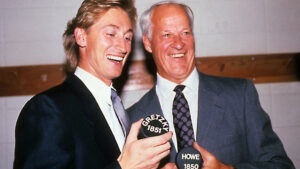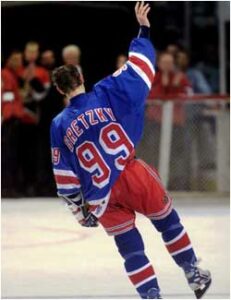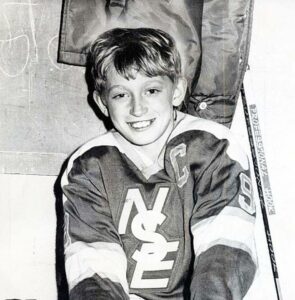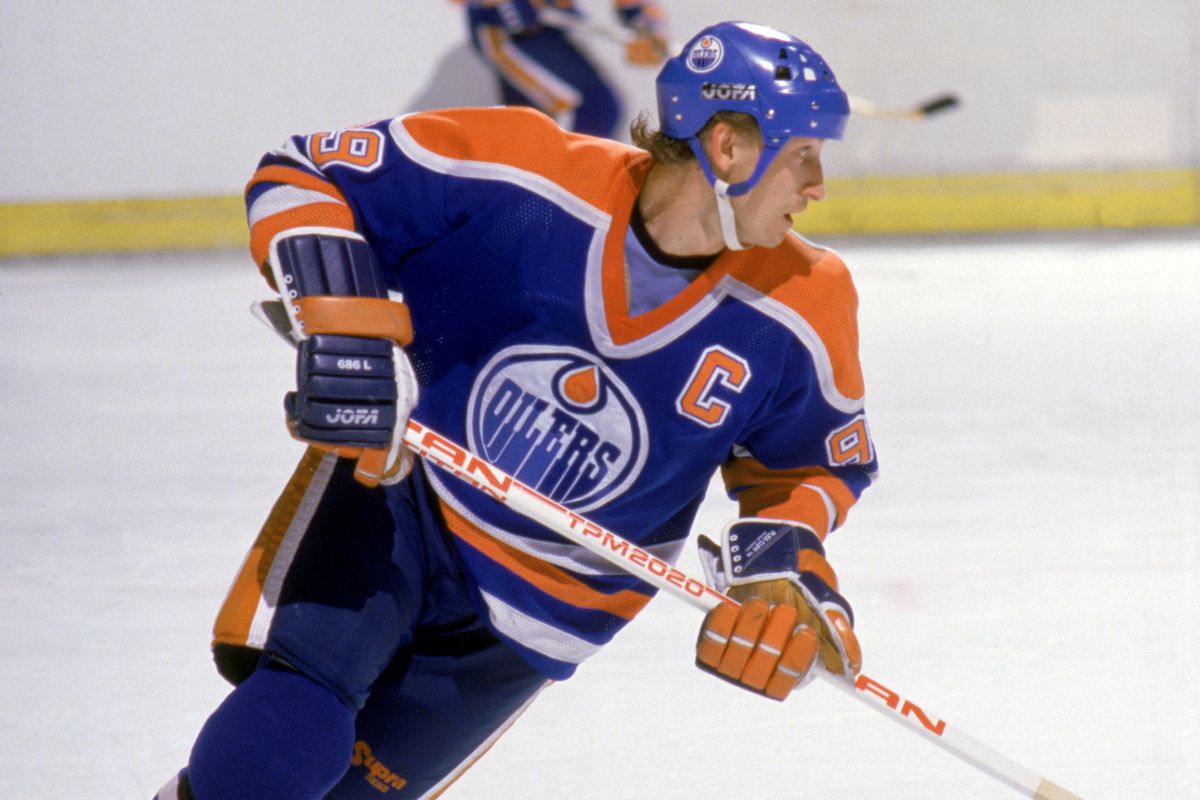Today is Wayne Gretzky’s birthday, and it’s a big one. Since the Great One is turning 60, I thought it would be appropriate to mark the occasion with a post celebrating Gretzky’s achievements and his contributions to the game of hockey.
I must admit, one of the reasons I thought this would be a good topic – even if I wasn’t writing it around his birthday – is because it seems like Gretzky gets some disrespect these days from people who don’t really understand how good he was.
That’s astonishing, but it’s true. I see this mostly on social media from fans that are too young to have seen him play, so they dismiss his greatness by dismissing the era when he played (i.e., goaltending wasn’t as good as it is now, overall scoring was much higher in Gretzky’s heyday, players today are bigger/faster/stronger, etc.).
Those things are all true, and yet they’re also not really relevant. Even in his era, Gretzky, though faster than many people give him credit for, was never the fastest skater on his team, and certainly wasn’t one of the 10-15 fastest skaters in the league. He was below average in size and strength. What set him apart then would set him apart in any era, and that was what was between his ears.
The bottom line is that if Wayne Gretzky was born 40 years later, and had grown up with the same exposure to modern training, nutrition, and equipment that other players have now, he would be just as uniquely dominant as he was against his peer group when he was playing. Hopefully, the tidbits in this post will help people see how truly special Gretzky was.
Records Are Made To Be Broken – Sometimes
Since it’s his 60th birthday, it seems appropriate to start with this fact… Gretzky either holds or shares 60 official NHL records. It was 61 records when he retired in 1999, but since then, he has lost ownership of two records and gained ownership of one.
When he has been asked about all his official records, Gretzky said the one he thinks will be hardest to break will be his record of scoring at least one point in 51 straight games. Not that I think that one will be broken anytime soon, if ever, but I think there are a couple others that are even more out of reach. Namely, his career records for assists and points. The margins are astounding – let’s take a look.
at least one point in 51 straight games. Not that I think that one will be broken anytime soon, if ever, but I think there are a couple others that are even more out of reach. Namely, his career records for assists and points. The margins are astounding – let’s take a look.
Gretzky’s 1963 career assists put him more than 700 ahead of the man in second place, Ron Francis. Joe Thornton has the highest total among active players with 1089 at the start of the 2020-2021 season, and he’s 41 years old. The next-highest active player is Sidney Crosby, with 801 before starting this season – more than 1100 behind Gretzky.
As for points, well, just consider the fact that based on his assists alone, Gretzky would still be the career points leader even if he had never scored a single goal in the NHL. With 2857 points, he’s over 900 points ahead of second-place Jaromir Jagr. The closest active players before the start of this season were Thornton with 1509, Alexander Ovechkin with 1278, and Crosby with 1263. No way any of those players are catching Gretzky. In fact, I think the only one with a chance of getting within 1000 points of him is Crosby, and even that is highly unlikely.
Times Change
One of the most common arguments I see used to try to diminish Gretzky’s numbers is the fact that for much of his career, and especially in his prime, overall league scoring was higher than it has been over the last 20+ years.
There’s some truth to that. Goaltending has changed: bigger goalies, bigger equipment, and different techniques have made it harder to score goals than it was 40 years ago. Defensive systems are more advanced now, too.
At the same time, there are some aspects of today’s game that counteract the trend toward lower scoring, which Gretzky didn’t have the benefit of during his career. Back in the 1980s, players were using wood sticks, not the modern composite sticks, which are rocket launchers by comparison. Maybe even more importantly, the evolution in officiating has opened the game up so much more. If hooking, holding, and interference were called as closely in the 1980s as they are today, Gretzky would have been able to rack up even more points with all the power plays.
benefit of during his career. Back in the 1980s, players were using wood sticks, not the modern composite sticks, which are rocket launchers by comparison. Maybe even more importantly, the evolution in officiating has opened the game up so much more. If hooking, holding, and interference were called as closely in the 1980s as they are today, Gretzky would have been able to rack up even more points with all the power plays.
One thing that Gretzky’s detractors seem to overlook is that even if it was so much easier to put up big offensive numbers in his heyday, somehow, nobody else was taking advantage of it to nearly the same degree. If you look at the list of the NHL’s career scoring leaders, many of them played during the same era as Gretzky: Mark Messier, Ron Francis, Steve Yzerman, Bryan Trottier, Doug Gilmour, Dale Hawerchuk, Jari Kurri. But the closest of those players to Gretzky in career points is Messier, and he’s 970 points behind, despite playing five years longer than Gretzky.
Proportion Matters
It’s impossible to come up with an exact “exchange rate” to figure out how numbers would translate across eras, but it’s easy to see how dominant Gretzky was in his era. One of the most obvious indicators is that in four different seasons, Gretzky’s assists on their own would have been enough to lead the league in scoring even if he didn’t score any goals (one of those seasons he would have tied for the lead, but still…). I haven’t checked the entire history of the NHL, but nobody else has done that even once in the last 50 years.
Let’s look at it from another angle. In the 10 seasons in which Gretzky won the Art Ross Trophy as the league’s leading scorer, his margin over the player who finished second was more than 20% on eight occasions. Six of those times, the margin was more than 40%, including five times greater than 50% and twice greater than 60%.
For comparison, of all the other players that have led the league in scoring since 1970, only two have had 20%+ more points than the player finishing second (Phil Esposito by 25% in 1973, and Bobby Orr by 21% in 1970). Most years, the margin is less than 10%.
In short, the difference between Gretzky and his competition is something that is virtually impossible to do for even one season, and Gretzky did it consistently.
Aging Gracefully
One of the amazing things about Gretzky’s career is how durable he was. That’s especially true considering how much “extra” hockey he played over the years. He played in 208 playoff games in his 20-year NHL career, the equivalent of an additional 2.5 full regular seasons. On top of that, he played for Canada in four Canada Cup tournaments, one World Cup, one World Championship, and the 1998 Olympics; combined, those tournaments represent another 57 games.
Gretzky always saw a lot of ice time, too. Ice time stats aren’t available before Gretzky’s last season in 1998-1999, but in that season, during which he turned 38, he averaged 21:04 per game. It stands to reason that he was getting even more ice time than that for the bulk of his career.
during which he turned 38, he averaged 21:04 per game. It stands to reason that he was getting even more ice time than that for the bulk of his career.
So Gretzky played heavy minutes in all situations, and squeezed in a ton of extra hockey in the playoffs and international play. He was smaller and weaker than the average player. He had the puck on his stick a lot, and he was the focal point of opposing teams’ defensive efforts.
Despite all that, somehow Gretzky managed to mostly avoid serious injuries throughout his career. He missed 39 games with a back injury during the 1992-1993 season, and 16 games in the 1987-1988 season, but otherwise he never appeared in fewer than 70 games in a season.
How did he manage to stay healthy given all the factors above, which you would think would lead to fatigue and subsequently injuries? The easy answer is to point to teammates like Dave Semenko and Marty McSorley, Gretzky’s protectors in Edmonton and, in McSorley’s case, Los Angeles. Both acted as deterrents against opponents that might have taken liberties with Gretzky. The prevailing thinking is that the prospect of having to drop the gloves with either player (or another of Gretzky’s teammates) if they were too rough with Gretzky meant lots of guys weren’t as physical with him as they could have been.
I think that argument has some merit, but only a little bit. The fact is that throughout Gretzky’s career, all NHL teams had at least one player that filled that role of protector for his team’s star player(s). Some of them were solid players in their own right and played a regular shift, while others only got on the ice to send a message with their fists.
Why do I point this out? Well, to put it simply, because the notion that Gretzky had some unfair advantage because he had guys like Semenko and McSorley riding shotgun with him ignores the fact that all of the other stars had similar protection, but didn’t come anywhere close to Gretzky’s production. Were Semenko and McSorley more intimidating than Bob Probert and Joe Kocur when they played with Steve Yzerman in Detroit? Or Denis Savard’s bodyguards in Chicago, who included Al Secord, Behn Wilson, and Dave Manson, among others?
I don’t think so. So, while Gretzky might have gotten a little extra room because of guys like Semenko and McSorley, all of the other stars around the league got the same extra room because of their teams’ enforcers. And again, none of the other stars put up numbers like Gretzky’s.
How, then, did Gretzky stay consistently healthy and productive for so long? There’s no single answer, but two of the biggest factors are part of what made Gretzky’s game so unique in the first place.
The first is a physical aspect of Gretzky’s style of play – he was hard to hit. Denis Potvin once said that trying to lay a solid hit on Gretzky was like trying to wrap your arms around fog. Other opponents used different analogies – checking a deer, catching a feather in a breeze – but the point is the same, Gretzky was elusive.
Both Gretzky and his father, Walter, credit another sport for helping him develop that elusiveness. Gretzky was a very good lacrosse player growing up, and the ability to absorb and roll off a check in lacrosse was something that translated well for him on the ice.
The other thing that I point to is Gretzky’s exceptional awareness. When opponents had the puck, he had incredible anticipation that helped him intercept passes. When he had the puck, he knew where his teammates were without looking. It only makes sense that his ability to read plays and “eyes in the back of his head” intelligence would also translate into the ability to sense an oncoming check and angle his body away to diminish the force.
Consistency Counts
Considering that for pretty much his entire career, Gretzky was the biggest focus for other teams when they were putting together their defensive game plans, it’s remarkable how consistent he was offensively. In 1487 career games, he only went without a point in 203 of them. By contrast, he had 824 multi-point games, more than anyone else in NHL history; Jaromir Jagr is second with 540, and he played in 246 more games than Gretzky.
Think about that for a second. That means that over his entire career, Gretzky averaged just 11 pointless games per full season. It’s mind boggling.
And even when he was doing something remarkable, like when he was in the midst of his 51-game point-scoring streak, he managed to make it even more impressive. During the streak, Gretzky had more games with four or more points (15) than games with one point (13). Over the course of the 51 games, he recorded 153 points, an average of exactly three points per game.
In his 20-year NHL career, Gretzky led the league in scoring 11 times, finished second and third twice each, and fourth once. The only season he averaged less than a point per game was his final season in 1998-1999, when he scored 62 points in 70 games. In both of the two previous seasons, he had finished in the top four in scoring and led the league in assists.
Beyond The Numbers
I’ve thrown a lot of numbers and statistics at you, and those show how dominant Gretzky was, but what really made him special was how different he was. Like so many players, Gretzky put in countless hours practicing his skills, beginning in early childhood. Unlike most players though, he was at the same time studying the patterns and tiny details that most people wouldn’t think about – or if they did, they wouldn’t think could be understood.
wouldn’t think could be understood.
It’s that extra level of intellectual absorption of tendencies within the game that made Gretzky unique. Writer Peter Gzowski once said about Gretzky, “What we take to be creative genius is in fact a reaction to a situation that he has stored in his brain as deeply and firmly as his own phone number.”
That’s what allowed Gretzky to anticipate an opponent’s pass and pounce to intercept it; what allowed him to take the best angle to a 50/50 puck and come away with it against bigger and faster players; and what allowed him to find open teammates for passes that surprised not only the opposing players, but often his own teammates too.
In short, Gretzky was an artist. Other players have some artistry in their games, but Gretzky’s artistry was his game. If you didn’t see him play, be grateful for YouTube, because we’ll never see another one like him.
Victory Lap
Ok, now I want to hear from you. if you’re a fan of 99, please share your favorite memories of watching him play. If you don’t think he’s the greatest hockey player of all time, who do you think is? Let’s have some fun debating this – I’m ready, Penguins fans! 😉 Regardless of who tops your list of the best players ever, I hope you enjoyed this little celebration of Wayne Gretzky’s birthday. Thanks for reading, and please leave your comments below.
